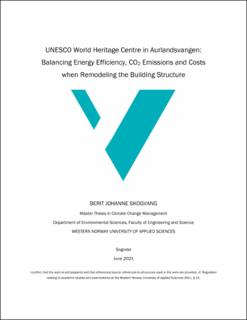| dc.description.abstract | Greater focus on energy-efficient buildings made of low-emission material has potential to reduce large amounts of greenhouse gas emissions, thus creating a more sustainable construction industry. Since cost is often decisive for construction projects, it is essential to include this aspect. This thesis thus intended to find a balance between energy consumption, CO2 emissions and cost for the remodeling of the UNESCO World Heritage Centre in Aurlandsvangen and investigate how such a balancing impact the concept choices. The concepts are intended to suit the architectural design made by MAD Architects, and they have been chosen based on inspections of the case building, technical building assessment of the existing building carried out by MultiConsult and discussions with the project manager.
The thesis focuses on the remodeling of the building structure itself, including wall, roof, slab on ground, windows, and doors. Three concepts have been developed for each building part, and four methods were implemented for the 15 concepts. The methods included u-value calculations to find the u-value of the concepts, energy simulation in SIMIEN to quantify the amount of saved energy compared to a TEK17 remodeling, as well as saved money and emissions from saved energy. Furthermore, life cycle assessment in One Click LCA were conducted, to quantify CO2 emissions, and cost estimates were produced. The results laid the foundation for the balancing.
Choices were made to weight all factors equally. For other project it may be sufficient to weight differently, however, it is important to emphasize that cost should not be prioritized above the remaining factors. Nevertheless, the balancing process is most affected by the choices made in advance of the balancing. All recommended concepts are used in at least one of the extreme concept combinations, which indicates that the chosen concepts represent a thorough balancing, and that the choices made prior have been carefully completed.
The project itself meets several of the Sustainable Development Goals, however, for the detailed engineering, efforts should be made to ensure a more sustainable building design. This because the glass façade will result in high energy consumption, high emissions, and a large cost. | en_US |

